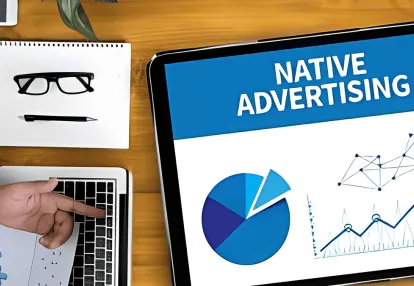
Our spy tools monitor millions of native ads from over 60+ countries and thousands of publishers.
Get StartedIn the realm of digital marketing, native advertising has emerged as a potent tool for connecting with target audiences. It's a type of online advertising where ads blend seamlessly into the platform they're placed on, mirroring the look and feel of the surrounding content. This chameleon-like capability enables native ads to engage audiences without disrupting their browsing experience.
Native advertising mistakes, however, can be costly, zapping the effectiveness of your campaigns and negatively impacting your bottom line. A well-executed campaign can boost brand awareness, increase customer engagement, and drive conversions. On the flip side, missteps in native advertising can lead to wasted resources, damaged brand reputation, and lackluster campaign results.
The stakes are high in this game of digital persuasion. Understanding common pitfalls is key to navigating the landscape successfully. Let's delve into the most common mistakes advertisers make when running native ads and explore practical strategies to turn these challenges into opportunities for growth and success.
Selecting the optimal native ad platform is a pillar for campaign success. Just as a craftsman chooses tools that match the intricacies of their work, advertisers must choose a platform that aligns with their creative strategies and business objectives. Consider The New York Times, where branded content harmonizes with editorial material, offering advertisers a prestigious environment to reach educated and affluent audiences.
Key factors in native ad platform selection include:
Taboola stands out as a recommended native ad platform, thanks to its expansive reach across numerous reputable publisher sites and advanced targeting options, which allow for strategic ad placements tailored to audience preferences and behaviors. By leveraging Taboola’s robust analytics, advertisers can gain insights into performance metrics, driving informed decisions for campaign optimization.
Engaging native ads play a crucial role in successful digital marketing as they directly impact click-through rates (CTR). When the content seamlessly blends with the platform and captures the audience's attention, it can result in significant performance improvements. Here are some strategies to help you craft effective native ads:
Use high-quality images and compelling headlines that spark curiosity. By leveraging visual storytelling, you can transport users into your brand's narrative, which increases the chances of them clicking on your ad and taking action.
Take the time to understand your target audience's interests and needs. This knowledge will enable you to tailor your messaging in a way that resonates with them, making each interaction with your ad feel personal and relevant.
Make sure that each ad you create provides some form of value to the user. Whether it's educational content, entertainment, or a solution to a problem they're facing, people should gain something worthwhile from engaging with your ad beyond just getting introduced to your product or service.
By blending your promotional goals with genuine user value, native advertising becomes a powerful tool for establishing meaningful connections with potential customers. This approach not only helps build trust but also encourages users to progress naturally through the sales funnel.
User Engagement
Quality content is essential for a successful native advertising campaign. It directly affects how users engage with your content and perceive your brand. When the content you provide doesn't meet their expectations, it can lead to negative outcomes. Let's take a closer look at this issue:
Audiences tend to disengage quickly with content that doesn't offer value or meet a professional standard. This disengagement can be seen through:
Low-quality content reflects poorly on your brand's reputation. Users may associate the lack of effort in the content with the quality of products or services you offer, leading to lasting negative perceptions.
Here are some tips to maintain high-quality content in your native ads:
Utilize high-resolution images and sleek graphics that are relevant to your messaging. The visual appeal can significantly impact a user's first impression and subsequent engagement.
While enticing headlines are crucial, they must accurately reflect the content's value. Misleading clickbait may drive initial clicks but ultimately results in user distrust and high drop-off rates.
Remember, substance coupled with style enhances the user experience and solidifies your brand's standing in a crowded digital marketplace.
Creating misleading native advertising experiences can pose significant risks, such as potential backlash from consumers and regulatory issues. Native ads should reflect the promoted content accurately, avoiding any ambiguity that could mislead users. Ensuring transparency and disclosure in native ads is essential, allowing users to clearly distinguish them from organic content.
Consider the case of ABC Company that faced severe criticism for their misleading native ad campaigns. They blurred the lines between sponsored content and organic posts, leading to a loss of consumer trust and penalties from regulatory authorities. This example underscores the importance of honesty in native advertising.
To avoid falling into the same trap:
Remember, misleading native ads can result in short-term gains but will invariably harm your brand's reputation in the long run.
Understanding the customer journey is essential for creating effective native advertising. Many campaigns make a common mistake by not matching their native ads with the different stages of the customer journey. This can greatly reduce the ads' effectiveness in leading people to take action.
The customer journey is like a roadmap that shows how someone becomes aware of, considers, and eventually decides to purchase a product or service. It's not a direct path but rather a series of steps and touchpoints along the way.
Each stage of the customer journey presents an opportunity for businesses to connect with potential customers. By understanding what people are thinking and feeling at each stage, you can create native ads that address their specific needs and concerns.
Here are some steps you can take to better understand the customer journey and tailor your native ads accordingly:
By aligning your native ads with the customer journey, you'll be able to deliver more personalized and impactful messages that resonate with your audience at every step of their buying process.
Lack of Customer Understanding
Here are two ways you can tailor your native ads to different types of viewers:
When targeting people who are new to your brand, focus on providing them with helpful and educational content that aligns with their interests. This could include things like:
The goal here is to introduce yourself in a way that is informative and valuable to them.
For people who have already interacted with your brand in some way, it's important to take a more personalized approach. This could involve showcasing things like:
By acknowledging their previous interactions and tailoring the content accordingly, you can increase the chances of converting them into customers.
Segmenting your audience and customizing your ad content has several advantages:
By taking this strategic approach to native advertising, you can create meaningful connections with your audience and drive better results for your business.
In native advertising, it's crucial to choose Key Performance Indicators (KPIs) that are aligned with your goals. These KPIs should reflect the specific objectives of your campaign and provide a clear measure of its success. When there is no alignment between KPIs and goals, it becomes difficult to determine whether your native ad efforts are actually contributing to your overall business objectives.
To address this challenge, here are some steps you can take to select appropriate attribution models:
By educating yourself about these attribution models and selecting the most suitable one for your campaign, you can ensure that every conversion is correctly attributed to native ad interactions. This will give you actionable insights instead of vague data, allowing you to optimize your campaigns for better return on investment (ROI) and customer engagement.
Split-tests, or A/B tests, serve as a compass in the ever-evolving landscape of native advertising. By rigorously testing variables such as ad formats, headlines, content types, audiences, and publishers, advertisers can uncover which combinations resonate most effectively with their target demographic. Here's why integrating split-testing into your strategy is not just beneficial but essential:
Testing ad formats against each other pinpoints which ones engage users more deeply.
Since headlines are the first point of contact, split-testing different variations can significantly lift click-through rates.
Discover which content types align best with audience interests and preferences.
Identifying the most responsive audience segments and the most suitable publishers helps in tailoring campaigns that speak directly to those groups.
For setting up split-tests, follow these steps:
The leverage gained from split-testing equips advertisers with actionable data to enhance campaign performance incrementally and systematically.
Active campaign monitoring is the heartbeat of any successful native advertising endeavor. Timely optimization based on real-time data can significantly elevate campaign performance. Advertisers need to be vigilant, tracking multiple metrics to swiftly pinpoint areas requiring attention or adjustment.
Key metrics essential for thorough scrutiny include:
By focusing on these indicators, advertisers detect not just issues but also opportunities for refinement. This approach enables responsive modifications that align with user behavior and campaign objectives, ensuring ongoing relevance and effectiveness of native ad strategies.
Learning from native advertising mistakes is a stepping stone to campaign optimization. Advertisers equipped with knowledge about these pitfalls can adeptly navigate the complex landscape of native advertising. The key is not just to avoid these errors, but to actively incorporate strategies that propel campaigns forward.
Here are some actionable steps you can take to improve your native advertising campaigns:
Regularly reviewing past performances helps identify patterns that may signal which practices to continue and which to revamp.
Adaptability is paramount. The digital marketing environment is in constant flux; hence, agility in strategy and execution ensures relevance and effectiveness.
Data analytics should guide every decision. By understanding what the numbers are saying, advertisers can fine-tune campaigns for optimal engagement and conversion.
Always place the audience’s needs at the forefront. Native ads should be a natural and value-adding part of their content consumption experience.
Embracing the latest trends and best practices in native advertising equips marketers with the tools needed to construct robust campaigns that resonate with audiences while achieving business objectives. This dynamic approach helps safeguard against costly errors that can arise from a static strategy.
Moving forward, it's essential to consider how additional resources can bolster your native advertising efforts. Utilizing advanced tools offers insights that could be pivotal in refining your strategies for even greater success.
Elevate your native advertising campaign with a powerful tool like Anstrex. As a leading native advertising intelligence tool, Anstrex provides valuable insights that can optimize your campaigns. Here are some features that set it apart:
With Anstrex, your campaign analysis is not just about what's not working; it's about discovering new avenues of opportunity and growth. So why wait? Try out Anstrex for your native ad campaigns today!
Receive top converting landing pages in your inbox every week from us.
Case Study
TikTok has emerged as a powerful advertising platform for e-commerce businesses looking to drive sales and grow their customer base. This case study from Peru demonstrates the immense potential TikTok holds for e-commerce businesses.
Kulwant Nagi
7 minJul 14, 2024
Featured
TikTok is a key growth channel for Shopify in 2024. Start by adding the TikTok sales channel in Shopify, linking TikTok For Business, Business Center, and Ads Manager, and installing the TikTok Pixel with your chosen data sharing level. In Ads Manager, build campaigns → ad groups → ads, pick Product Sales (with a linked catalog), target by demographics/interests/behavior, and set a daily or total budget (often $20–$50 minimum). Test optimization goals—Clicks, Landing Page Views, and Conversions—to see what scales. Use short video creatives, Spark Ads, creator content via post codes, clear CTAs, and relevant keywords/hashtags. After approval, track analytics and iterate. For strategy, use Anstrex In-Stream to research competitors by filters, keywords, products, and stores, then model high-performing, demo-style, localized ads.
Jairene Cruz
7 minApr 25, 2024
Must Read
In the realm of digital marketing, native advertising has emerged as a potent tool for connecting with target audiences. The stakes are high in this game of digital persuasion. Understanding common pitfalls is key to navigating the landscape successfully.
Marcus Chen
7 minFeb 22, 2024





